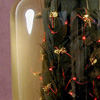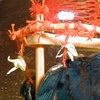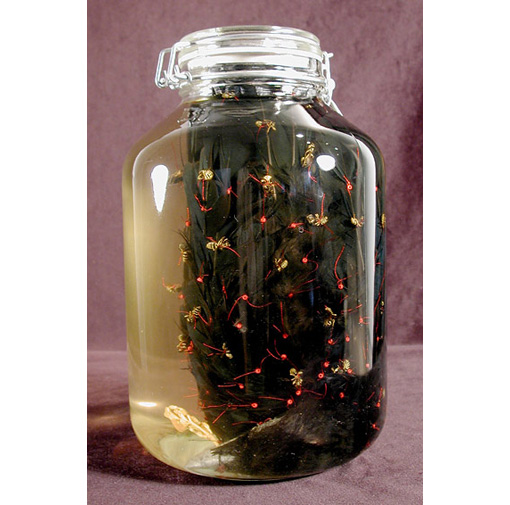



It was a known fact that West Nile Virus was killing the Jays and Crows in nebraska. So, it was with reluctance that I removed my latex gloves in order to tie two hundred knots while attaching yellow jackets and red seed beads to the feathers of a dead crow.
I was breeding mice in an aquarium to provide a food source for the Argentina Horned Frogs I keep as pets. Inspired by a display located at Chicago's Museum of Science and Industry, I thought preserving mice in alcohol might be the best strategy for an art piece about regular intervals of time and the development of young mice.
In Chicago's Museum of Natural History, one may gaze upon necklaces made from human finger bones or the brightly colored heads of tropical birds. I have seen earrings made from beetles and broaches to tether living anoles as adornment. Thus it was a logical connection for me to see the opalescent translucence of newborn mice as gem stone like and suitable for human decoration.
Both of these birds were discovered drowned in a windmill fed cattle watering tank; neither bird was there the day before. Their double drowning inspired a double entombment in glass.

The lidded jars function like the glass contained environment of aquaria or the glass in a picture frame. In my mind the glass is ignored (until it shatters) but not the shape of the contents. Now, as in my boyhood, the inside of a jar is the arena of contained experiment.
The Jar Sculptures are an extension of my assemblage with natural materials research. This blending of scientific and metaphysical thinking to make art about natural history and myself has been the major theme of my artistic life. This work is not art about the nature of art, its art about nature and my accumulated experience and education.
In biology departments I have seen: closets for jars with two headed cows and human hearts, drawers and drawers of stuffed birds and rodents, rooms and rooms of dried insects stuck to pins logically arranged by family and genus. I have gained permission to visit the basements of medical schools where I made drawings and photographs of dissected cadavers in the tradition of the Renaissance artists.
My mother allowed me my own shelf in the freezer in which to store insects and other perishable treasures. My amateur paleontologist uncle instilled an early love in me for bones, fossils, rocks, and other treasures to be “collected” from nature. These collections have become my art materials.